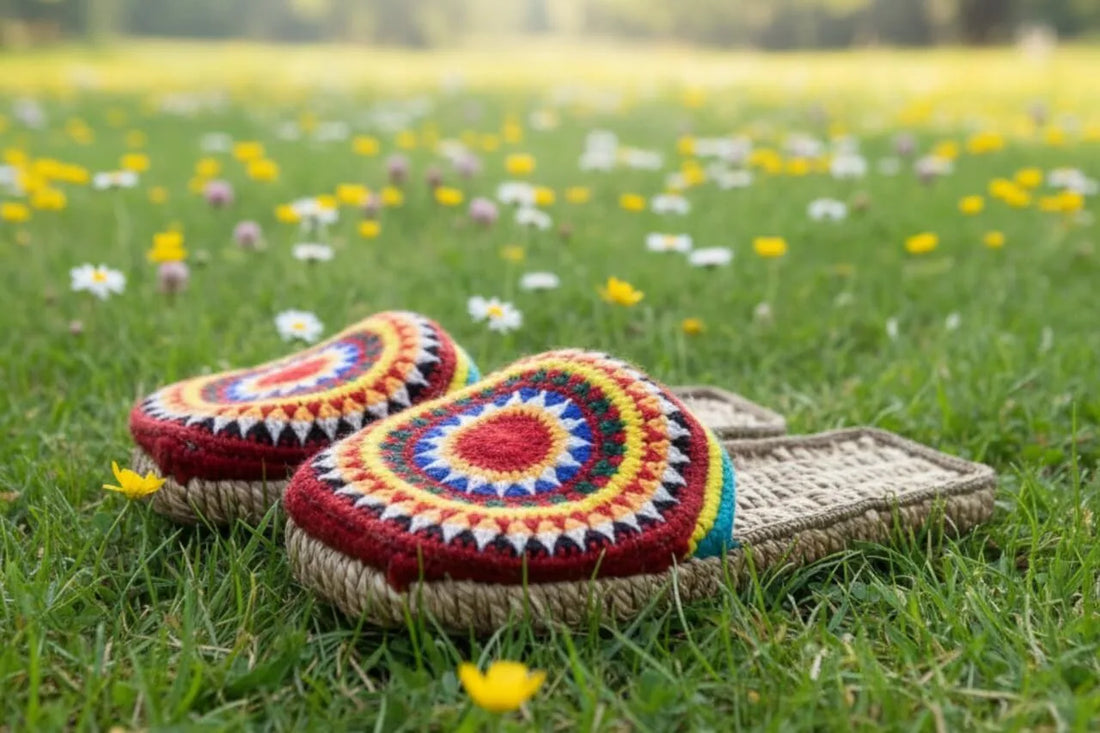
Pullas – Himachal’s Grass-Woven Slippers Keeping Tradition Alive
The morning sun rises over the Kullu Valley, and inside a small wooden house, an artisan sits cross-legged with bundles of dried grass at her side. Her hands move swiftly, twisting fibers into thick braids, shaping them into soles, and decorating the uppers with bright wool threads. The faint, earthy fragrance of dried grass fills the air. These humble creations are called Pullas — slippers handwoven out of grass, hemp, and wool — a craft that has been part of Himachali life for centuries.
But as synthetic footwear floods the markets and leather shoes dominate the streets, the question arises: will these eco-friendly, cultural slippers survive the test of time?
Origins & Cultural Significance
Pullas are native to Himachal Pradesh, especially the valleys of Kullu, Seraj, and Jalori. For generations, locals have relied on the materials provided by their environment — grass, hemp (bhang), goat hair, and bark — to create footwear that is not only functional but deeply tied to their way of life.
In many Himachali homes and temples, leather is avoided because of its religious connotations. Pullas became the perfect solution: natural, durable, and respectful of cultural practices. They are often worn during winter festivals, rituals, and inside sacred spaces, symbolizing purity and simplicity. More than just footwear, they represent a way of living in harmony with nature.
Craftsmanship & Making Process

The creation of Pullas, Himachal's traditional grass-woven slippers, is a detailed and beautiful craft. It starts with gathering wild grass or hemp, which is then dried in the mountain sun and prepared for weaving. These fibers are twisted, sometimes using a simple spindle called a takli, and braided into thick ropes.
These ropes are then shaped and hand-stitched to form the sturdy soles. The upper part of the slipper is adorned with bright wool embroidery, often featuring geometric or floral patterns that are unique to the artisan or the valley. The result is a lightweight, warm, and distinctive slipper, unlike any mass-produced footwear.
Each village adds its unique touch; some use bark fibers, while others experiment with embroidery styles, ensuring that no two pairs of Pullas are ever exactly alike.
Challenges & Adaptations
Like many traditional crafts, Pullas face an uncertain future. The ban on hemp (bhang) cultivation, changing lifestyles, migration of younger generations, and the influx of cheap synthetic slippers have made it harder for artisans to keep the craft alive. Climate change has also affected the availability of raw materials.
Yet, all hope is not lost. Local cooperatives, NGOs, and even small businesses are reviving Pullas with modern twists — experimenting with new materials, making them more comfortable, and marketing them as eco-friendly slow fashion. Tourists and urban buyers are beginning to see their value not just as slippers but as heritage pieces worth preserving.
Why Should Someone Buy Pullas ?
-
Comfort & Wellness: These natural fiber slippers promote breathability, absorb moisture, and offer a gentle acupressure sensation for your feet.
-
Sustainability: 100% natural and biodegradable, Pullas leave behind no harmful footprint.
- Fashion & Aesthetic: Their rustic charm makes them a versatile accessory for boho, cottagecore, and minimalist styles.
In a world obsessed with fast fashion, Pullas reminds us of the beauty of slow, thoughtful living.
How to Buy, Care & Support

If you’re considering buying Pullas, here are a few tips:
-
Authenticity: Look for handwoven soles and embroidered uppers — machine-made copies often lack the raw, natural feel.
-
Price: Genuine Pullas may cost more than synthetic slippers, but they carry the weight of tradition and sustainability.
-
Care: Keep them dry, air them out regularly, and avoid damp conditions to ensure they last longer.
By choosing Pullas, you’re not just buying footwear — you’re supporting local artisans, sustaining an age-old tradition, and walking a little closer to nature.
Conclusion
Pullas are more than just slippers. They are stories woven in grass, symbols of Himachali culture, and proof that sustainable living doesn’t have to compromise on beauty or comfort.
As traditions fade in the rush of modern life, every pair of Pullas bought and worn becomes a quiet act of preservation. So the next time you slip them on, remember: you’re not just walking in slippers — you’re walking in history.

If you ever visit Himachal, you’ll often find Pullas being sold in local fairs, village markets, or even by artisans themselves in smaller towns. They’re usually tucked away in stalls alongside woolens and handicrafts. For those who can’t make it to the hills, cooperatives like Bhuttico in Kullu also keep them — since they’ve been working with weavers and artisans for decades, you know you’re getting something authentic. It’s one of those things that’s best bought directly from the source, where you can actually see the craft and meet the people behind it.
